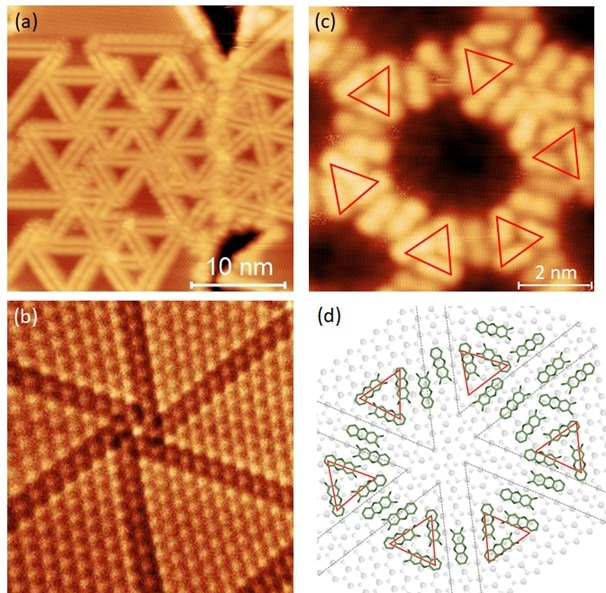Jul 12 2019
NUS scientists have developed a method for self-assembly of hexagonal organic porous structures on molybdenum diselenide (MoSe2) film to create ordered nanostructures.
 Figures show the formation of a DAP porous structure on MoSe2 MTB networks. A prototypical DAP pore which is formed distinctly mimics the features of the MoSe2 “wagon-wheel” pattern. (a) Scanning tunnelling microscope (STM) image of the single-layered MoSe2 film. (b) Atomic force microscope image of the MoSe2 film which shows a typical “wagon-wheel” pattern. (c) STM image of a prototypical DAP pore and (d) the corresponding atomic configuration. [Credit: Nature Communications]
Figures show the formation of a DAP porous structure on MoSe2 MTB networks. A prototypical DAP pore which is formed distinctly mimics the features of the MoSe2 “wagon-wheel” pattern. (a) Scanning tunnelling microscope (STM) image of the single-layered MoSe2 film. (b) Atomic force microscope image of the MoSe2 film which shows a typical “wagon-wheel” pattern. (c) STM image of a prototypical DAP pore and (d) the corresponding atomic configuration. [Credit: Nature Communications]
The properties of two-dimensional (2D) transition metal dichacogenides (TMDs) are often strongly modified by defects which are introduced during their growth process. When two grains, which are mirror images of each other, coalesce during the growth process, a grain boundary is formed. This creates a line defect known as a mirror twin boundary (MTB). Although MTBs are usually unfavourable for carrier/ energy transport and optical applications, they are often catalytically active and can potentially be used as templates for self-assembly of molecules at the nanoscale.
A research team led by Prof Andrew WEE from the Department of Physics, NUS which includes research fellows Dr HE Xiaoye and Dr HUANG Yuli, have developed a method for the self-assembly of 2,3-diaminophenazine (DAP) molecules on MoSe2 film grown using molecular beam epitaxy. The MoSe2 film contains a dense network of MTB defects with a pseudo periodic “wagon wheel” pattern. Through the self-assembly process, DAP molecules arrange themselves in a porous structure with alternate linear-type and triangular-type configurations following the hexagonal “wagon-wheel” pattern of the underlying MoSe2 layer. DAP is an organic compound with promising luminescence, electrochemical and biochemical applications. These findings demonstrate that the site-dependent electronic and chemical properties of MoSe2 monolayers can be exploited as a natural template for nano-patterning purposes.
This site-specific molecular self-assembly process is attributed to the more chemically reactive MTBs compared to the pristine semi-conducting MoSe2 domains. First principles calculations by the research team show that active MTBs couple with amino groups in the DAP molecules, facilitating the assembly process.
Explaining the significance of this work, Prof Wee said, “These defective TMDs and porous organic molecule structures can find potential applications such as site-selective catalysis, molecular sensors or flexible organic optoelectronic devices. This work offers a novel pathway to nano-pattern 2D TMD surfaces at the atomic level, and provides a platform to explore the local chemical properties of MoSe2.”
Reference
He, X; Zhang, L; Chua, R; Wong, PKJ; Arramel, A; Feng, YP; Wang, SJ; Chi, D; Yang, M*; Huang, YL*, Wee, ATS*, “Selective self-assembly of 2,3-diaminophenazine molecules on MoSe2 mirror twin boundaries” NATURE COMMUNICATIONS Volume:10 Article Number: 2847 DOI: 10.1038/s41467-019-10801-0 Published: 2019.